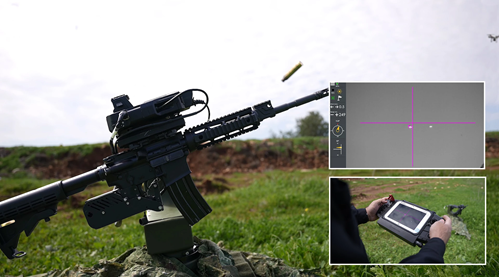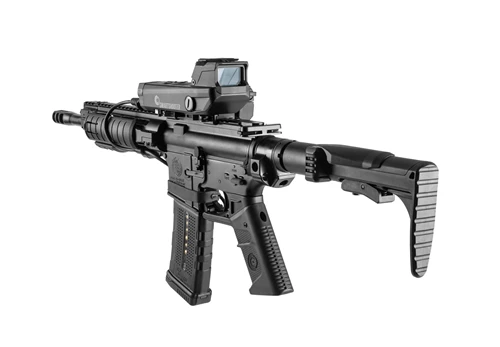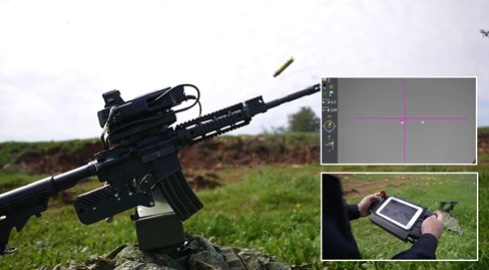The fire monitoring system SMASH has been introduced to the battlefield during the war against Hamas. This operational support tool weighs less, identifies the enemy within seconds, can lock on targets and assist in eliminating them and quadruples our forces’ chances of hitting their target.
In the heart of Gaza, danger lurks around every corner. Explosive-carrying drones and terrorists are only some of the challenges our troops are facing. In order to neutralize these threats, troops must open fire. However, “the target doesn’t simply sit still waiting for us,” reminds Major Yoav, Head of the Infantry and Commando Department in DDR&D (Administration for the Development of Weapons and Technological Infrastructure).

So how do they handle a moving target, and how do they improve their chances of hitting it? DDR&D has found the solution. The SMASH Sight isn’t just your average Sight, it is a fire monitoring system that assists our soldiers in hitting moving targets with precision. Simply put, unlike a regular sight that gives the soldier a guiding point according to which they can aim their barrel, the SMASH Sight enables the soldier to follow their target, lock in on it and fire at it at the exact second that will guarantee a hit.
The innovative fire monitoring system considers a number of variables: from the target’s direction and pace of movement to the ballistics of the weapon it is mounted on. The small computer integrated into it calculates the data and improves the accuracy of the hit.
The SMASH Sight is so sophisticated that it can predict the future location of the target and match the times the target and the bullet fired reach that location.
“The chances of hitting a moving target with the first shot—which is the most significant one—are low,” admits MAJ Yoav, “but a soldier using the SMASH Sight quadruples their chances. We’re talking about an almost guaranteed hit of an individual or an object that poses a threat, and the timing of pulling the trigger becomes simpler.
To activate the sight, the soldier presses a button at the front of the weapon called PTT. A continuous press on it puts the system into “Target Search” mode, where every potential target in the sight’s range is marked with a rectangle.
The soldier then chooses a target from those offered to them and lets go of the PTT, allowing the sight to lock onto the chosen target and circles its center of mass.
The soldier is, of course, still in control of the initial aim of the weapon and pulling the trigger. “If their barrel isn’t exactly aimed at the target, the pull wouldn’t be completed and the soldier will run into a short ‘barrier’ (the weapon won’t fire), but if the barrel is aimed at the spot the sight calculated as accurate, the bullet will exit the barrel and the shot will be completed.”
This way, the soldier has control over the actual pulling of the trigger, but the bullet will only be released when the chances of hitting the target are high. As for the fear of the weapon jamming permanently—A slight shake of the weapon will deactivate the sight and allow the soldier to fire freely without encountering a ‘barrier’.
This SMASH initiative began years ago. Back in 2018, when the IDF was required to defend towns and communities against incendiary kites and balloons, the first SMASH Sight was operationalized. It was quite heavy and cumbersome, but fulfilled its purpose. Still, our Ground Forces demanded a lighter, more operational solution.

Nowadays, the SMASH Sight weighs only 700 grams, meaning it is no heavier than any other special sight, and in relation to the results it provides—quadruple chances of hitting the target—the extra weight becomes insignificant.
Thousands of the sights are currently being used by soldiers in the war against Hamas. When the Golani Brigade’s 51st Battalion was attacked by explosive-carrying drones, they were able to neutralize seven drones within seconds using the SMASH sight.
“We plan on increasing the sight’s distribution in the near future, training more reservists to use it, improving its night operational capabilities and developing an option for soldiers to be able to identify our own troops by looking through it in order to avoid friendly fire incidents (incidents in which soldiers are misidentified as the enemy and fired at by their own force),” concludes MAJ Yoav.
B’Chasdei Hashem for the intelligence that Israel continues to develop saving countless lives.

















Some logistics should not be posted …. Duh